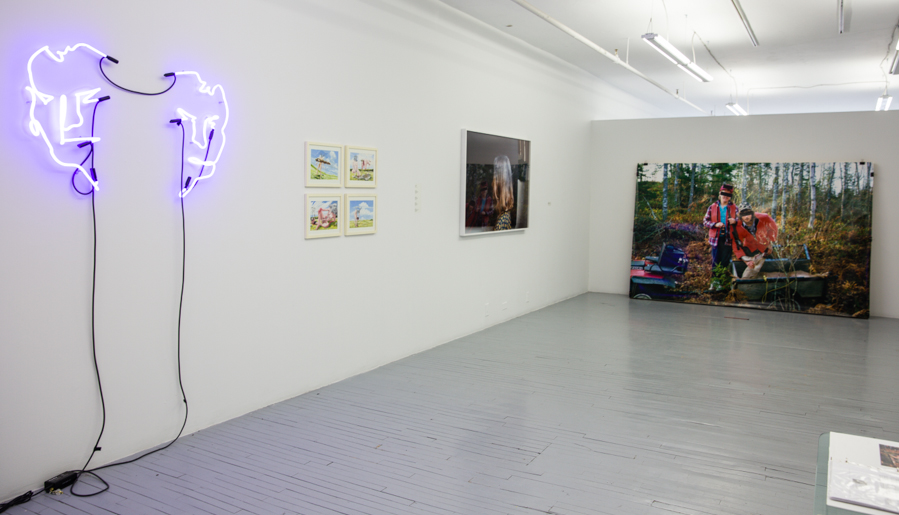Complex structures that alter both physical and behavioural characteristics, hormones rarely possess a social identity. Out of this whirling chemical mass, however, testosterone has developed a certain notoriety, due to its socially constructed link to masculinity and gender. In Galerie Donald Browne’s current exhibit, “Testostérone: Mythologies Identitaires,” seven artists of various gender identities broadly tackle this significance and ambiguity that society consistently attaches to the hormone.
The most stereotypical portrayal of testosterone associates the hormone exclusively with an alpha-male personage. Upon entering Galerie Donald Browne, the first eye-catching piece is one that explicitly addresses this traditional definition of testosterone. The piece is a redux of an intense, untitled chromogenic photograph from the 1990s, found in London and modified by artist Shari Hatt. Though it’s located at the far end of the gallery, the photo manages to attract the viewer’s gaze with its immense size, detail in colouring, and because it is the most ‘typical’ portrayal of male testosterone in the exhibit.
The photo’s subjects are two young men, on a hunting excursion, with one holding up the limp head of a recently killed animal. They are surrounded by the tell-tale masculine symbols of beer, a four-wheeler, and a gun. The artist has physically covered logos and eyes with duct tape — perhaps to represent the universality of this hunting scene as a stereotype of testosterone. The tape makes expressions harder to determine, emphasizing the mouths as a more primal facial feature: eyes portray emotion, mouths portray desire. Yet, like many other pieces in the exhibition, the photo represents a profound contradiction by also conveying a sense of bonding, friendship, and shared experience.
Also striking are Louis Fortier’s three mythological wax sculptures, on display at the very entrance of the gallery. They go by the names of Uranus, Saturne, and Janus, each modeled after parts of Fortier’s own body — hands, palms, and face. Uranus is a sculpture mounted to the wall, a black head separated from a pink sphincter. The grey Saturne faces Uranus but is itself placed on a pedestal instead of being mounted on the wall. In Roman mythology, Saturn is considered god of the Capitol, and his reign is associated with the Golden Age of wealth and abundance. In the gallery his face is distorted, his nose crooked, his teeth jagged. Janus, the first Roman god, has two faces that overlook the entire gallery, and represent power over all elements of the universe. Fortier’s mythological sculptures evoke male dominance since the beginning of history with a constant struggle for power. The harshness of both Hatt’s redux and Fortier’s gods are a critique of traditional male stereotypes in and of themselves. Where the pieces fall short is in failing to create a distinction between testosterone as a hormone and testosterone as a construction of gender identity.
Other pieces, however, such as Raymonde April’s Sans Titre and Olivier Gariépy’s L’Écho de Narcisse, blur the dichotomy between ‘male’ and ‘female’ to creatively and cleverly address the constructed role testosterone plays in gender. These artists play with testosterone’s relation to gender identity and urge the viewer to bend definitions, curtail previous opinions and form and appreciate grey areas. They make use of mythology to explore the classical roots of today’s patriarchal society. Sans Titre, a large chromogenic photograph, also focuses on the effects of how hormone levels fluctuate with age.
More specifically challenging is Jenna Meyers’ beautiful oil creation of deep purple and warm orange hues, entitled Frankie. Frankie is an expressionist depiction of a pensive figure gazing off into a distant realm, whose ambiguously ‘male’ body once again blurs gender binarism. Jérome Ruby’s acrylic and neon paintings, on the other hand, illustrate the historical effects of testosterone by focusing on primal archaism juxtaposed with some modern elements. His acrylics glow of brilliant landscapes, nude characters with headless bodies, blood, and power lines. These headless people partake in primal hunting and cooking rituals (one even cooks another human on a stick), displaying a captivating contrast between gore and beauty.
The curation, organization, and layout of pieces of the exhibit is what ties together all of these diverse interpretations of testosterone. Simply by featuring artists of varying gender identities and sexualities, the exhibit promotes the equal value of perspectives from across the spectrum of gender identities, and affirms that testosterone is not the property of straight, cis men. These artists’ pieces thrive in ambiguity, contrast, and abstract meaning – testosterone, the natural steroid.
As with many art exhibits, what the viewer will extract is highly dependent on how familiar they are with the stories referenced. While this exhibit displays contemporary art saturated in mythologic references, you do not need a background in classics to appreciate it — the ideas in and of themselves are thought-provoking enough. That said, some prior knowledge of Saturn, Orpheus, and Janus may come in handy. This exhibit serves as a reminder that the effects of testosterone and its stereotypes extend far beyond the traditionally defined ‘male’ body to reach and touch all aspects of life.
The exhibit runs until September 6 at Galerie Donald Browne and is open from 12 p.m. to 5 p.m. every Wednesday to Saturday.

